
The refugee crisis is an important topic around the world, especially in Europe and our students are able to see a glimpse of it in their city. That is why Savremena International School organised an interdisciplinary day to ensure that our students meet this important issue from a place of understanding and compassion as well as insight into the nuances and general context of the issue.
Through a series of discussions, workshops and video materials, Savremena’s students were able to learn about the hardships the refugees face and receive answers to various questions they may have had on the matter.
Biology: The health problems in migrations
In their biology lesson, our students learned about migrations through history, starting with the migrations from Africa 100.000 years ago. Students realised that migrations are a common phenomenon in civilisational development and they found out what kind of a toll they can have on a person’s health as well as how to help and assist people on the move.
To understand the complexity of the vaccination issue, students were separated into two groups and discussed the arguments in support of and against vaccination. One group had to research online and find all the advantages of vaccination as well as the recommended vaccinations people traveling into EU countries should receive.
At the same time, the other group researched the risks and potential consequences of vaccines that prompt people to opt out of inoculation. Backed up by their newly-acquired knowledge, the representatives of both groups presented their arguments in a debate.
Geography: Displacement and its consequences
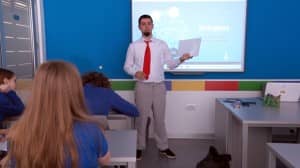 The geography lesson was structured as a study on the genocide in Rwanda which displaced around 2 million people. After students learned about the civil war in Rwanda, they received their working papers and maps showing different refugee camps.
The geography lesson was structured as a study on the genocide in Rwanda which displaced around 2 million people. After students learned about the civil war in Rwanda, they received their working papers and maps showing different refugee camps.
With the help of these materials, students analysed the population density, living conditions and similar issues from the geographic angle. They were also able to find the common thread between Rwanda, the conflicts in Syria, the war in Yugoslavia and other such crises and understand the weight and magnitude of their consequences on local populations.
Chemistry: Refugees caught in the crossfire
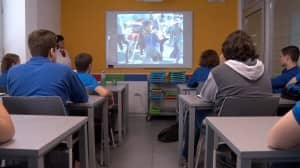 The chemistry lesson was centred around two topics, weapons of mass destruction and the refugees caught in the crossfire. This form of weaponry is anything but a monolithic menace including different kinds of nuclear, chemical, biological and radiological threats used for different purposes, from intimidation on an international scale to devastating terrorist attacks with toxic gasses and anthrax.
The chemistry lesson was centred around two topics, weapons of mass destruction and the refugees caught in the crossfire. This form of weaponry is anything but a monolithic menace including different kinds of nuclear, chemical, biological and radiological threats used for different purposes, from intimidation on an international scale to devastating terrorist attacks with toxic gasses and anthrax.
Students learned about the different categories of WoMDs, their distribution, trade and consequences. To truly understand the devastation that comes with weapons of such a high calibre, the lesson included images and visuals demonstrating their destructive power.
Global Perspectives: Learning about Human Rights
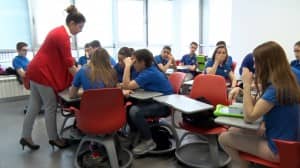 In order to learn about human rights, in their global perspectives class, students watched a number of short videos upon which they discussed the issue of equality.
In order to learn about human rights, in their global perspectives class, students watched a number of short videos upon which they discussed the issue of equality.
As an empathy and insight building exercise, students watched a video documenting an asylum seeking family’s journey to Austria, upon which through a UNHCR designed practice they were able to retrace a part of the torturous journey and get a sense of what it feels like to leave everything behind and flee for your life with no guarantee of tomorrow.
English Language: Feeling the weight of the language barrier
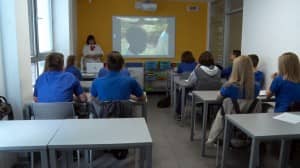 Making a valuable contribution to Savremena’s interdisciplinary day and the issue of refugees, the Where are you from presentation in their English language class, enabled students to explore the stereotypes about people of different backgrounds, religions, races etc. as they reexamined their own biases and delved deep into how they are formed. Words matter - some can carry a stigma and undermine the issue while others are more welcoming and our students learned about the nuances between terms like migrant, asylum seeker and refugee.
Making a valuable contribution to Savremena’s interdisciplinary day and the issue of refugees, the Where are you from presentation in their English language class, enabled students to explore the stereotypes about people of different backgrounds, religions, races etc. as they reexamined their own biases and delved deep into how they are formed. Words matter - some can carry a stigma and undermine the issue while others are more welcoming and our students learned about the nuances between terms like migrant, asylum seeker and refugee.
Yet, the most memorable part of the lesson was when with the help of the BBC website, students assumed the role of refugees and selected the route they were to cross to get to safety. Fleeing for their lives, those who survived the dangerous journey reached their destination but the gates were closed. To be granted asylum, the students were given a form to fill in by their teacher who acted as the border control officer. Their life in that moment hinged on a piece of paper with a set of questions written in gibberish, a language they couldn’t possibly understand. With everything they had gone through, and the hope that pushed them forward, seeing what the life of a refugee is reduced to and the weight of the language barrier truly made students understand their struggle, the importance of language and what the phrase “I am you” means.
Serbian Language : Writing letters of support and encouragement
Recognising that as parts of a society in close contact with refugees, there is something constructive they can do, our students wrote letters of support and encouragement to show refugees that despite the hardships they may face compassion and kindness lies behind every corner.
After a reminder of the proper form, elements and structure of letters, students watched a number of heart-wrenching interviews in which refugees recalled some of the hardships they have faced. In the end, students expressed their emotions and encouragement for those who need it the most.
Arts: Important events through the camera lens
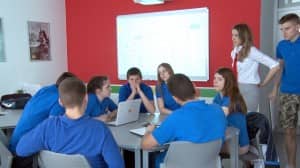 In their arts class, students explored and discussed documentary photography. Through a series of photos depicting the lives of refugees, Savremena’s students analysed the main features of documentary photographs.
In their arts class, students explored and discussed documentary photography. Through a series of photos depicting the lives of refugees, Savremena’s students analysed the main features of documentary photographs.
In addition, they learned about art as a form of activism as well as the different media that can be used to highlight social issues. At the end of the lesson, with the help of their iPads they designed and created a poster on the subject, thus exercising their own form of social activism.
Understanding pressing issues through interdisciplinary lessons
The different activities conducted during this interdisciplinary day were all specifically designed to help our students understand what the people who are forced to leave everything behind are going through and analyse the issue from different perspectives thus constructing an informed view into the depth and complexity of the issue that refugees are facing.
That is how Savremena International School teaches its students to become responsible individuals who understand, empathise with and help the most vulnerable members of our society.


















